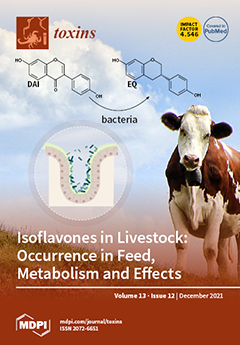Fusarium chaquense, a recently formally described novel species, has been identified as an T-2 toxin (T-2), HT-2 toxin (HT-2) and other toxins producer in natural grasses (Poaceae) from Argentina. The major objective of this study was to describe the effect of water
[...] Read more.
Fusarium chaquense, a recently formally described novel species, has been identified as an T-2 toxin (T-2), HT-2 toxin (HT-2) and other toxins producer in natural grasses (Poaceae) from Argentina. The major objective of this study was to describe the effect of water activity (a
W, 0.995, 0.98, 0.95, 0.93 and 0.91), temperature (15, 25 and 30 °C) and incubation time (5, 15 and 25 days) on growth and to evaluate the production of T-2, HT-2 toxins and beauvericin (BEA) by two
F. chaquense strains in a grass-based media. The results showed a wide range of conditions for
F. chaquense growth and mycotoxin production. Both strains had a maximum growth rate at the highest a
W (0.995) and 25 °C. Regarding mycotoxin production, more T-2 than the other analysed mycotoxins were produced by the two strains. T-2 production was favoured at 0.995 a
W and 30 °C, while HT-2 production at 0.98–0.95 a
W and 15 °C. The maximum levels of BEA were produced at 0.995 a
W and 25–30 °C. Two-dimensional profiles of a
W by temperature interactions were obtained from these data in order to identify areas where conditions indicate a significant risk of mycotoxins accumulation on grass. For its versatility on growth and mycotoxin production in a wide range of a
W and temperatures,
F. chaquense would have an adaptive advantage over other
Fusarium species, and this would explain its high frequency of isolation in natural grasses grown up in the Chaco wetlands.
Full article






